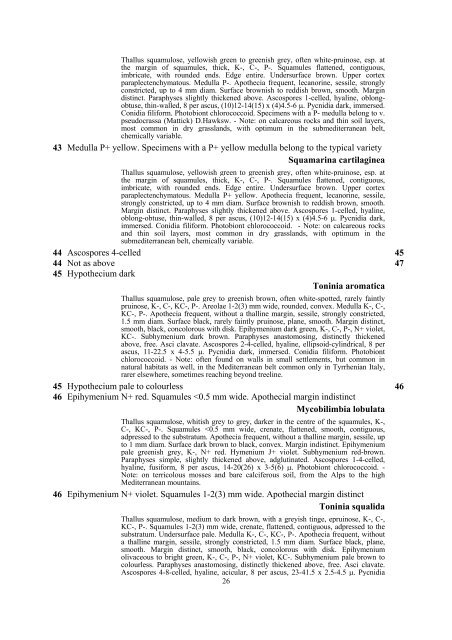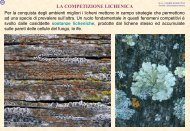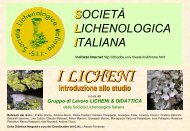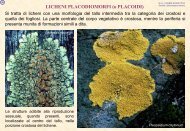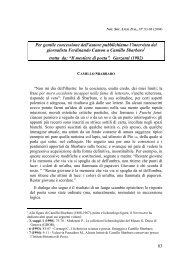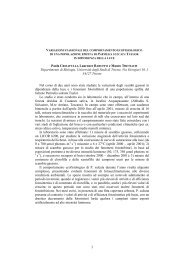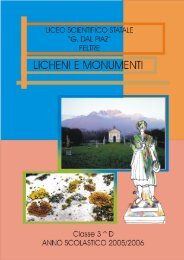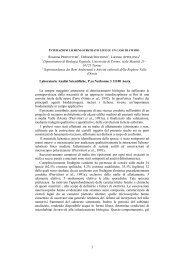KEY to terricolous lichens - italic
KEY to terricolous lichens - italic
KEY to terricolous lichens - italic
Create successful ePaper yourself
Turn your PDF publications into a flip-book with our unique Google optimized e-Paper software.
Thallus squamulose, yellowish green <strong>to</strong> greenish grey, often white-pruinose, esp. at<br />
the margin of squamules, thick, K-, C-, P-. Squamules flattened, contiguous,<br />
imbricate, with rounded ends. Edge entire. Undersurface brown. Upper cortex<br />
paraplectenchyma<strong>to</strong>us. Medulla P-. Apothecia frequent, lecanorine, sessile, strongly<br />
constricted, up <strong>to</strong> 4 mm diam. Surface brownish <strong>to</strong> reddish brown, smooth. Margin<br />
distinct. Paraphyses slightly thickened above. Ascospores 1-celled, hyaline, oblongobtuse,<br />
thin-walled, 8 per ascus, (10)12-14(15) x (4)4.5-6 µ. Pycnidia dark, immersed.<br />
Conidia filiform. Pho<strong>to</strong>biont chlorococcoid. Specimens with a P- medulla belong <strong>to</strong> v.<br />
pseudocrassa (Mattick) D.Hawksw. - Note: on calcareous rocks and thin soil layers,<br />
most common in dry grasslands, with optimum in the submediterranean belt,<br />
chemically variable.<br />
43 Medulla P+ yellow. Specimens with a P+ yellow medulla belong <strong>to</strong> the typical variety<br />
Squamarina cartilaginea<br />
Thallus squamulose, yellowish green <strong>to</strong> greenish grey, often white-pruinose, esp. at<br />
the margin of squamules, thick, K-, C-, P-. Squamules flattened, contiguous,<br />
imbricate, with rounded ends. Edge entire. Undersurface brown. Upper cortex<br />
paraplectenchyma<strong>to</strong>us. Medulla P+ yellow. Apothecia frequent, lecanorine, sessile,<br />
strongly constricted, up <strong>to</strong> 4 mm diam. Surface brownish <strong>to</strong> reddish brown, smooth.<br />
Margin distinct. Paraphyses slightly thickened above. Ascospores 1-celled, hyaline,<br />
oblong-obtuse, thin-walled, 8 per ascus, (10)12-14(15) x (4)4.5-6 µ. Pycnidia dark,<br />
immersed. Conidia filiform. Pho<strong>to</strong>biont chlorococcoid. - Note: on calcareous rocks<br />
and thin soil layers, most common in dry grasslands, with optimum in the<br />
submediterranean belt, chemically variable.<br />
44 Ascospores 4-celled 45<br />
44 Not as above 47<br />
45 Hypothecium dark<br />
Toninia aromatica<br />
Thallus squamulose, pale grey <strong>to</strong> greenish brown, often white-spotted, rarely faintly<br />
pruinose, K-, C-, KC-, P-. Areolae 1-2(3) mm wide, rounded, convex. Medulla K-, C-,<br />
KC-, P-. Apothecia frequent, without a thalline margin, sessile, strongly constricted,<br />
1.5 mm diam. Surface black, rarely faintly pruinose, plane, smooth. Margin distinct,<br />
smooth, black, concolorous with disk. Epihymenium dark green, K-, C-, P-, N+ violet,<br />
KC-. Subhymenium dark brown. Paraphyses anas<strong>to</strong>mosing, distinctly thickened<br />
above, free. Asci clavate. Ascospores 2-4-celled, hyaline, ellipsoid-cylindrical, 8 per<br />
ascus, 11-22.5 x 4-5.5 µ. Pycnidia dark, immersed. Conidia filiform. Pho<strong>to</strong>biont<br />
chlorococcoid. - Note: often found on walls in small settlements, but common in<br />
natural habitats as well, in the Mediterranean belt common only in Tyrrhenian Italy,<br />
rarer elsewhere, sometimes reaching beyond treeline.<br />
45 Hypothecium pale <strong>to</strong> colourless 46<br />
46 Epihymenium N+ red. Squamules


